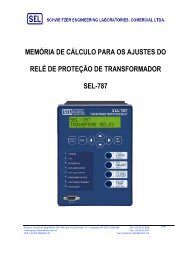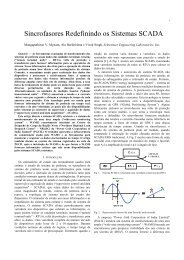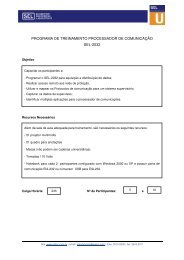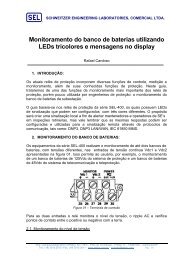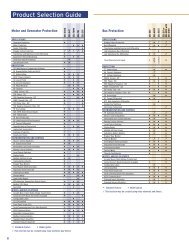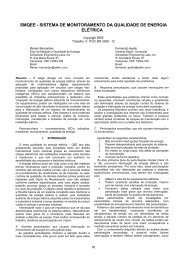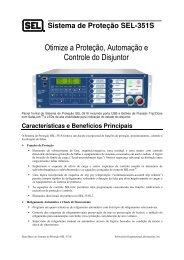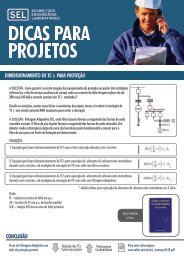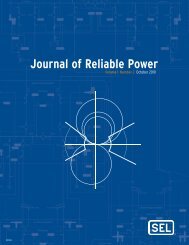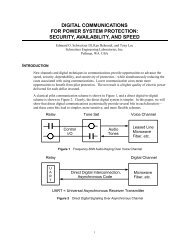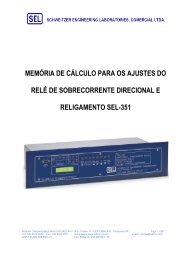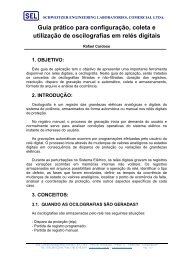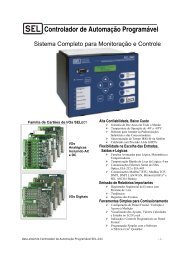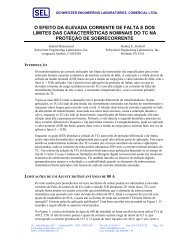Journal of Reliable Power - SEL
Journal of Reliable Power - SEL
Journal of Reliable Power - SEL
You also want an ePaper? Increase the reach of your titles
YUMPU automatically turns print PDFs into web optimized ePapers that Google loves.
8<br />
Fig. 15 depicts the same experiment but with a primary Rf<br />
equal to 50 ohms. The high-speed element has an operating<br />
time <strong>of</strong> 14.5 milliseconds, whereas the conventional element<br />
has an operating time <strong>of</strong> 25 milliseconds.<br />
1<br />
0.8<br />
High-speed distance calculation<br />
Fig. 16 illustrates the negative-sequence network <strong>of</strong> a<br />
simple transmission line and the respective source impedances<br />
at both terminals. If possible, this two-source network should<br />
be evaluated. If the system is slightly more complex (e.g.,<br />
parallel lines), a short-circuit program can provide the IF2 and<br />
IR2 currents. The calculation should be done for a fault at the<br />
reach <strong>of</strong> the Zone 1, where m is approximately 80 percent.<br />
Distance to Fault (pu)<br />
0.6<br />
0.4<br />
Conventional distance calculation<br />
0.2<br />
Conventional trip<br />
High-speed trip<br />
0<br />
0.1 0.11 0.12 0.13 0.14 0.15 0.16<br />
Time (s)<br />
Fig. 15. High-speed and conventional distance element calculations for a<br />
50-ohm, A-phase-to-ground fault at 33 percent <strong>of</strong> the line length<br />
As a general rule, the quadrilateral high-speed logic will<br />
send an output signal a half cycle before the conventional<br />
logic. This corresponds most <strong>of</strong> the time to an overall subcycle<br />
operation for low Rf values. As illustrated in the two examples<br />
above, as Rf increases, both the fault current and the voltage<br />
dip will be reduced. Under these circumstances, the operation<br />
times <strong>of</strong> the high-speed and conventional quadrilateral<br />
elements will increase so that overall operation times close to<br />
or above 1 cycle will be more typical for high-resistance<br />
faults.<br />
III. QUADRILATERAL DISTANCE ELEMENT APPLICATION<br />
A. Homogeneity Calculation<br />
The reactive line in a quadrilateral distance element can be<br />
polarized with either negative-sequence (IR2) or zerosequence<br />
(IR0) current to properly adapt to load flow, as<br />
shown in Fig. 11. Polarizing with these currents makes the<br />
line adaptive and less susceptible to overreach. A check is<br />
needed, however, to ensure effective Zone 1 quadrilateral<br />
ground and phase distance element behavior [13]. This check<br />
is for the homogeneity <strong>of</strong> the negative-sequence impedances<br />
(or zero-sequence impedances, if zero-sequence polarization<br />
has been used).<br />
In a ground fault or asymmetrical phase fault, the total fault<br />
current always lags the source voltages. This fault current, IF,<br />
is the perfect polarizing current. It is in the same direction<br />
regardless <strong>of</strong> the type <strong>of</strong> fault (same angle but with different<br />
magnitude). Because the IF current is not measurable, the<br />
measured currents at the relay location are the only ones<br />
available. The negative-sequence current is an option for<br />
polarizing the reactance line <strong>of</strong> the quadrilateral element. The<br />
protective relay is measuring the local IR2 (negative-sequence<br />
current). The IF2 current is the proper current to use.<br />
Fig. 16.<br />
Two-source negative-sequence network<br />
The variable T is the homogeneity factor, and it is the angle<br />
difference between the fault current and the current measured<br />
at the relay location. Reference [12] illustrates the evaluation<br />
<strong>of</strong> this factor, which is the following current divider<br />
expression:<br />
⎛ IF2 ⎞ ⎡ ZS1 + ZL1 + ZR1 ⎤<br />
T = arg ⎜ ⎟ = arg ⎢ ⎥ (15)<br />
⎝ IR2 ⎠ ⎣ ZR1 + (1 − m) ZL1 ⎦<br />
The angle T in (15) adjusts the measured IR2 current to the<br />
angle <strong>of</strong> the fault current IF2. It is used in (3) and (8) to<br />
properly polarize the reactance line <strong>of</strong> the quadrilateral<br />
element.<br />
When the ground quadrilateral element is polarized with<br />
zero-sequence current (IR0), use a similar expression to<br />
calculate T (15), except that the currents and impedances are<br />
zero sequence.<br />
Equation (15) also provides some extra information<br />
regarding the homogeneity <strong>of</strong> the sequence network. For most<br />
transmission networks, the impedance angles in the negativesequence<br />
network are very similar. Evaluating (15) yields a<br />
small angle, usually in the range <strong>of</strong> ±5 degrees. On the other<br />
hand, in the zero-sequence network, the homogeneity angle<br />
varies considerably more.<br />
In (3) and (8), the reactance line is effectively tilted by the<br />
T angle.<br />
B. Load Encroachment<br />
The quadrilateral distance elements discussed in this paper<br />
are inherently immune to load encroachment. The reactive line<br />
that defines the reach is polarized with negative-sequence<br />
currents, as shown in (3) and (8). The phase and ground<br />
reactive lines start their computation when there is a fault<br />
condition that implies an unbalance <strong>of</strong> (I2/I1) or (I0/I1) greater<br />
than the natural unbalance <strong>of</strong> the system, which is less than<br />
10 percent.<br />
In a full protection scheme, however, there should be<br />
provisions to detect three-phase faults. Although rare, this<br />
type <strong>of</strong> fault is possible. It usually is a fault with almost no Rf.<br />
72 | <strong>Journal</strong> <strong>of</strong> <strong>Reliable</strong> <strong>Power</strong>



